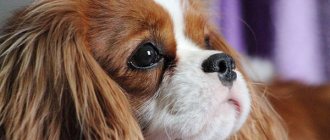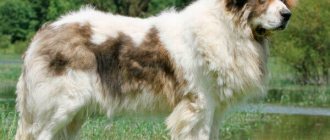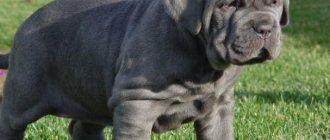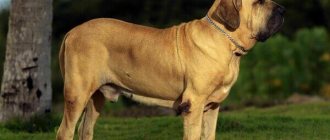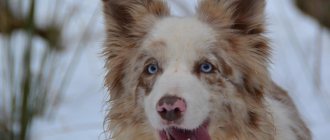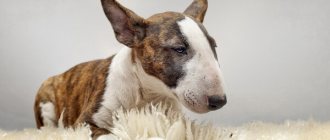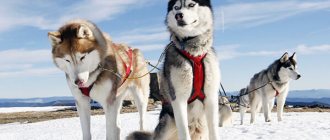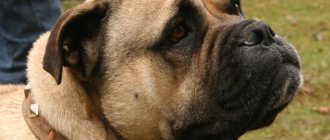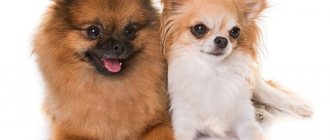Mastiffs are a large group of breeds that include Tibetan, English, French, German, Pyrenean, Major, American, Brazilian, Pakistani and other varieties of these dogs.
Spanish Mastiffs are large and strong dogs, the stern expression of their muzzle can terrify anyone who is not familiar with this breed.
In fact, it is simply impossible to say that they are ferocious. Once you get to know them better, their good-natured attitude and affectionate nature immediately become noticeable.
However, there are several features that everyone who is thinking about purchasing this dog should know in advance.
In the article you will find a description of this breed, its characteristics and features.
History of the breed
There are many versions of the origin of Spanish mastiffs, but only 2 of them are the most reliable. Some scientists say that the ancestors of these dogs were brought to Europe by Phoenician merchants, others are inclined to believe that they owe their appearance here to Asian nomads.
Mastiffs are similar to Turkish, Caucasian, Balkan and Tibetan shepherd dogs, so it is impossible to reliably determine which of them is the ancestor of the Spanish mastiffs, but it is likely that all these breeds have common roots.
It is known that Spanish mastiffs existed as a separate breed back in the 15th century. and were engaged in grazing cattle in the Pyrenees.
NOTE!
This dog breed became widely known only at the beginning of the 20th century, and the first standard was determined at the end of the Second World War. Having gained international recognition, Spanish Mastiffs became even more popular, but were still inferior to German Shepherds and Rottweilers.
Spanish mastiffs were brought to Russia in the mid-90s from a Czech nursery.
Interesting Facts:
- Until 1929, this breed was called a little differently - “mountain Spanish mastiff”.
- Spanish shepherds, who still use these dogs as workers, say that they are invincible - they never succumb to wolves and always win in a fight.
- These are dogs of late maturation: males reach maturity by three years, females by two.
Health
The Spanish Mastiff lives on average 10-12 years under appropriate conditions. This breed of dog is characterized by fairly good and strong health if the birth of a puppy was preceded by high-quality selection.
A very important point in the health of a pet is its proper nutrition. You should not feed your dog human food because of the preservatives and dyes it contains. Potatoes are also strictly prohibited. River fish, pork, sweets, baked goods - all this is poison for the mastiff and can significantly undermine its health.
Description and standard
Spanish Mastiffs are large, strong, proportionally built dogs. When you see representatives of this breed, you cannot help but notice their grace and grandeur. The sense of dignity of these dogs can be read in their entire appearance - from their posture and gaze to their demeanor in public and their unfettered, swift, free movements.
Characteristics of the breed standard:
- the head is large, but harmonious relative to the body;
- the transition from the forehead to the expressive, powerful muzzle is weakly expressed;
- the skin is thick, does not fit tightly;
- rectangular body;
- the chest is powerful and deep;
- The loin is wide and powerful, the croup is muscular;
- the shoulder and shoulder blades are wide;
- the stomach does not sag slightly due to the large volume of skin;
- limbs are strong, straight, set wide and parallel to each other, the hind limbs are more powerful;
- paws are large, oval;
- powerful jaws, scissor bite;
- the nose is large and black;
- eyes oval, brown;
- there are wrinkles on both sides of the eyes, giving the dog a serious appearance;
- The ears are triangular, hanging, set wide and low.
The coat is of medium length, thick, close to the body, slightly wavy, the undercoat is thick and dense.
Appearance
The Spanish Mastiff is a large dog, well-built, muscular, powerful, with a large head and medium-length hair. The body has an elongated shape, but harmony and lightness should be traced in movements and proportions. gender identity is guessed very well. The height at the withers for males is from 77 cm, for females - from 72 cm. Weight is not defined by the standard, with a minimum size of 70-80 kg. The head is strong, large, shaped like a truncated pyramid with a wide base. The skull is strong, with a pronounced occipital protuberance and a convex profile. The large upper lip covers the lower lip, and the jowls are well developed. The teeth are strong and white. The eyes are small in relation to the skull, almond-shaped, preferably dark in color. The eyelids are pigmented and thick. A slightly drooping lower eyelid allows you to see the mucous membrane. The ears are drooping, triangular in shape, flat, medium in size, and can be cropped.
The sky is black. The neck is strong, flexible, with a well-developed dewlap. The body is rectangular in shape, powerful and strong, indicating great strength, but at the same time mobile. The back is flexible and powerful. The ribs are rounded. The loin is wide and long. The croup is strong, its height is equal to the height at the withers. The chest is deep, wide, very powerful. The tail is thick, reaching to the hocks, and the terminal quarter is often curved. The front legs are straight, parallel, strong, with powerful pasterns. The hindquarters are straight when viewed from behind, with long and strong bones. The feet are round and the toes are close together. Single or double dewclaws are desirable on the front and hind legs, but their absence is acceptable. The skin is thick, elastic, forms many folds, and has good dewlap in the neck and abdomen. The coat is long, thick, with a well-developed undercoat, shorter on the legs, longer on the tail. The color can be different, the most valuable uniform ones are red of any shade, black, as well as any variants of these colors - motley and brindle.
The official breed standard was approved in 1981, and is determined by the following characteristics:
- 1. expectancy : 10–12 years.
- 2. Height: 72–78 cm.
- 3. Weight: 70-120 kg.
- 4. Color: red, fawn, brindle, black and white, black and red.
- 5. Coat: hard, medium length, thick undercoat.
- 6. Head: large, square-shaped. The eyes are brown, the ears are hanging, triangular in shape.
- 7. Limbs are long, well developed.
- 8. The tail is thick.
Character traits
By the appearance of these dogs one can judge their endurance and performance.
Despite their impressive size, which can frighten people unfamiliar with this breed, Spanish mastiffs have a calm, even and balanced character, while they are not devoid of self-esteem and feel superior to others.
The Spaniards are not aggressive and will never attack without a good reason. Outwardly, they seem melancholy and indifferent to everything, but this instantly changes as soon as the dog sees a threat.
Representatives of this breed behave calmly, affectionately and gently with the owner and other family members. They become reliable and devoted friends and faithful helpers. Spanish Mastiffs need their owner's attention, love and care.
These dogs get along well with children, become their nannies and protect them from dangers. They tolerate children's pranks and take part in games with pleasure.
The Spaniards do not have problems with other animals either - they are friendly towards other dogs, and for them cats, livestock and small pets are part of the owner’s property, which they consider it their duty to preserve and protect.
Expert opinion
Kozhevin Semyon Kirillovich
Expert dog handler.
Spanish mastiffs are absolutely not characterized by causeless aggression, anger and disobedience. These are good-natured and calm dogs, attached to their family and the territory entrusted to them - they do not try to escape by digging or jumping over a fence. However, in order for a dog to show its best qualities, it is necessary to make some efforts and seriously engage in its upbringing - an untrained and unsocialized Spanish Mastiff can be a threat, since not everyone can cope with it.
Feeding
The Spanish Mastiff is a fairly expensive dog to keep. His ancestors were working animals with excellent metabolism, which has been fully passed on to modern animals. Owners should immediately forget about the budget menu.
The strong and heavy skeleton of these dogs will require a huge amount of building material for its formation. Mastiff puppies grow quickly early in their lives, so they will need a high-quality, nutritious food. A one and a half month old baby should receive balanced nutrition 6 times a day, and dry food will not be enough here.
During the period of active growth, experts recommend adding more fresh meat (lean beef), dairy products (kefir, cottage cheese), boiled vegetables (except potatoes) and fruits to the diet. It is better to soak dry puppy food in warm water.
You should be careful about mixed feeding. And if the puppy does not tolerate it well, then it is better to exclude dry food from the diet and switch to natural food. It is important to adhere to the same diet as the breeder had during the first month of life in the new home.
At the same time, it is necessary to ensure that the dog does not overeat. Excess weight is an extra load on the joints and ligaments and the rest of the musculoskeletal system. For the same reason, it is necessary to monitor the puppy’s activity, not allowing him prolonged physical activity, but also not prohibiting him from moving.
It is very important that from the first days of being in the house the dog knows exactly where he can always find fresh water to drink. At the same time, you need to make sure that the puppy does not play with the water dish or overturn it, otherwise this game will be almost impossible to stop later.
A feature of dogs of this breed is their slow maturation, which lasts up to 2.5-3 years. While the animal is gaining mass, its behavior is that of a puppy. And nutrition during this period should be appropriate.
It is enough to feed an adult dog twice a day. Even if an adult pet eats dry food, it should still receive lean meat: chicken, horse meat or beef. The most important thing is not to overfeed!
Advantages and disadvantages
Loyalty and affectionate disposition are not all the advantages of Spanish mastiffs.
The advantages of this breed include:
- courage;
- endurance and performance;
- intelligence and learning ability;
- patient and unobtrusive disposition;
- ability to get along with other animals and children.
Minuses:
- stubbornness;
- need for constant attention;
- the need for physical activity;
- heavy shedding;
- not suitable for apartment living;
- late emotional maturation.
Puppies receive temperament at birth, but character development takes about 4 years. It is believed that Spanish Mastiffs are dogs that take a long time to mature, so most of the shortcomings of these dogs are associated with improper upbringing.
Care and maintenance
- This breed is designed to live over a large area . The best place would be a private house with a large area and a high fence. You should not have such an animal for an apartment. Firstly, he will be cramped, and secondly, one of the neighbors will definitely complain about such a tenant.
- He will be able to live in an enclosure. Be sure to take into account the size of the dog, make the enclosure large, provide shade, and insulate the booth well. The dog can tolerate any weather, but extreme heat or cold still has a negative effect.
- The Spanish Mastiff has a thick coat that protects it from any weather. She needs to be brushed daily to remove shed fur and dead skin cells. Then your pet will always look well-groomed.
- You need to walk your dog often . Each walk should last at least an hour. While walking, you need to keep him busy with physical activity and training. A sedentary dog can gain a lot of weight, and this will negatively affect his musculoskeletal system. Without walks, the dog will become embittered or passive.
- Check the animal's eyes and ears and wipe them every week. Use special sticks to brush your teeth. Trim nails every month if necessary.
Photos of colors
For Spanish Mastiffs, almost any coat color is acceptable. Most often, representatives of the breed are found with yellow-cream, black, brindle, fawn and white-black coat.
Walks
For the Spanish Mastiff - a dog, as already mentioned, of quite impressive size - long, but not burdensome walks in nature are necessary. This pet is not suitable for active athletes. Excessive stress can damage the joints and ligaments of a huge animal.
You need to be especially careful with puppies when the formation and growth of bones, muscles and ligaments occurs. However, regular swimming is beneficial for them. Water will relieve excess stress, but will keep the body moving.
Is it suitable for living in an apartment or outdoors?
Spanish Mastiffs cannot be kept in an apartment; they need space.
Dense coat and thick undercoat allow these dogs to withstand both heat and cold without problems, so the most suitable option is a heated indoor enclosure and regular walks outside the site.
IMPORTANT!
These dogs should not be kept on a chain. They need constant contact with a person and the opportunity to splash out energy.
Contents of the Spanish Mastiff
Although, at first glance, keeping a Spanish mastiff does not pose any particular problems - it is even called a dog for the lazy - but such a pet will still be beyond the capabilities of beginners in cynology. Practical experience in raising, raising and caring for large breeds is a must.
Hygiene
Regular care of a dog's skin and coat is not difficult, but this does not mean that such basic procedures can be ignored. The owner of a mastiff will need special tools for pet hygiene:
- a wide, high-quality furminator - it quickly removes falling awns;
- various massage brushes - ensure clean and healthy skin and coat;
- silicone or rubber “dog” mittens are very convenient for caring for the mastiff’s coat both at home and on a walk.
Simple hygiene procedures must become regular
Frequent bathing is not beneficial for this breed; two such procedures per six months can be considered the best option. But how to get rid of dirt, diaper rash in the folds of the skin, and a specific heavy odor? Many mastiffs do not like water, so swimming in natural ponds or hosing them down is not an option.
Advice from my own experience caring for large dogs: dilute apple cider vinegar in water at room temperature (two tablespoons per liter; you can replace it with one spoon of regular vinegar). The entire body of the dog, paying special attention to the folds of the skin, should be wiped in different directions with this slightly sour solution - a small terry towel or coarse knitted mitten is moistened in it, which, when dirty, is rinsed in clean water and moistened again in the solution. This way, your pet will receive fur cleansing and skin disinfection, and as a bonus, a pleasant and useful massage.
Other mandatory dog hygiene is no different from other breeds: you must not forget about trimming overgrown claws, regularly cleaning your teeth, ears and eyes; by the way, it is especially important to monitor eye health.
Feeding
A good appetite is a sign of health, but Spanish Mastiffs should not be overfed. Especially in puppyhood, when this can negatively affect the formation of the skeleton of a rapidly growing dog and, first of all, the formation of its paws. The Spaniards, like all canine giants, mature very late and are finally formed only by the age of three, or even later. All this time, their diet must be strictly controlled in terms of volume, quality, calorie content, and it must be balanced.
Small Spanish Mastiffs have a great appetite.
Therefore, experienced breeders strongly recommend that in the first year of a dog’s life, choose good food of high quality for it - these tips are also relevant in adulthood, when you can pay attention to the following options:
- Canine Adult Advanced Fitness Large Breed with Chicken;
- Hill's Science Plan;
- Blitz Adult Large & Giant Breeds;
- Royal Canin Giant Adult;
- Eminent Gold Adult Large Breed.
If you are categorically committed to “natural food” and have experience in creating a full menu, do not forget to include the following products in it:
- meat - beef or lean lamb;
- poultry - boneless chicken, preferably lightly cooked;
- offal - liver, kidneys, beef tripe;
- sea fish - boiled and deboned;
- eggs - chicken can be used, but quail is better;
- cottage cheese - low-fat, preference should be given to homemade;
- vegetables, fruits, herbs;
- porridge - in a minimal amount.
But here’s what you shouldn’t feed to a mastiff, as well as to a dog of any other breed:
- "human" dishes;
- fried, fatty, spicy and smoked foods;
- flour and sweet products;
- legumes and citrus fruits in any form;
- boiled bones, especially tubular ones.
Walk
Walking is necessary even for a Spanish mastiff living in a spacious area. However, you should not exceed the physical load for this dog, for example, trying to chase it after a bicycle - such experiments can end in failure. This giant cannot be overloaded or overworked; this is dangerous for its heart and joints.
Even a fragile girl can easily cope with a pair of well-mannered mastiffs
Training
It is no coincidence that the breed is considered highly intelligent - Spaniards love to study, although they do not strive to become excellent students, like the Germans. For them, it is much more important to get answers to their questions: to understand how to act correctly in a given situation.
The Spanish Mastiff needs constant contact with its owner.
The success of training directly depends on the experience of the trainer and his knowledge of the characteristics of the breed. You need to be patient, consistent and demanding, but under no circumstances put forceful pressure on the dog. It is much more productive to negotiate with these dogs in an amicable, positive way; praise and approval are very important to them. Since Spanish mastiffs take a long time to develop both physically and behaviorally, it is advisable not to stop regular training with them until the age of three.
Unfortunately, there are very few specialists in training Spanish mastiffs.
How to properly care?
Caring for representatives of this breed is not difficult, the main thing is to accustom your pet to hygiene procedures from childhood and carry them out regularly.
Wool and bathing
You need to brush your dog with a metal brush 2-3 times a week, and daily during the shedding period.
After each walk, you need to wash your pet’s paws and belly, and give him a full bath no more than once a quarter, using a special shampoo that matches his coat type.
Claws
With regular and long walks, the Spanish Mastiff's claws grind down to the required length on their own. If this does not happen, they need to be trimmed with a nail clipper about 1-2 times a month, and the sharp edge should be filed with a nail file.
NOTE!
If your pet has dewclaws, the claws on them must be shortened yourself, since they do not grind down.
Ears and eyes
Ears should be wiped once a week with a damp cloth to get rid of dirt and dust, and accumulated wax should be removed with a cotton swab.
The eyes should be examined for inflammation and increased lacrimation, and wiped with a cotton pad in the morning, removing any secretions that have accumulated overnight.
Reviews
The kindest creatures of the Spanish Mastiff breed collect mostly positive reviews. They deserve this attitude due to their impeccable characteristics as a friend, companion, nanny, and also a guard. Before deciding to purchase such a dog, it is recommended that you read the owners’ comments on the following websites:
Marina: “Friends gave us a puppy for our wedding. We were incredibly happy because we bought a house and were going to get a guard dog. True, my husband doubted our Henry’s abilities and believed that purebred dogs were not meant for this. But we soon became convinced that our boy is a wonderful protector and a very loyal friend!”
Pavel: “Since childhood I was fascinated by the breed. Naturally, when I could afford it, I bought such a dog. He lives in my apartment. There is not enough space, but I try to walk with him for a long time, as often as possible. He eats very well, mostly meat. Therefore, think a hundred times whether you can feed such a giant.”
Life expectancy and major diseases
Spanish mastiffs are strong and hardy dogs with a fairly strong immune system, however, they also have a number of breed diseases. Such pathologies are the result of many years of selection and are often inherited.
The most common diseases:
- hip dysplasia;
- volvulus;
- gonarthrosis;
- cataract;
- entropion of the eyelid;
- third eyelid adenoma;
- eczema;
- bursitis.
The average life expectancy of representatives of this breed is 12-15 years.
Dossier
Adult dog height: 77 cm. Weight: 90 kg. Characteristic color: plain of any shade. Coat length: medium. Life expectancy: up to 11 years. Advantages of the breed: good guard, smart, loyal, does not require any special care. Difficulties of the breed: suitable for living in a private home, requires education and training. Average price of a Spanish Mastiff : $500-4000. Classification: large, security guard.
How and what to feed?
In order for a dog to grow healthy and develop properly, it needs to be provided with proper, balanced nutrition, including the required amount of proteins, fats, carbohydrates, vitamins and minerals.
The diet of Spanish mastiffs can be based on both natural products and industrial feeds, the main thing is not to mix both types of food, as this can lead to problems with the gastrointestinal tract and cause an excess or deficiency of minerals.
Each type of nutrition has its own advantages and disadvantages.
Thus, a natural diet is varied and eliminates the possibility that the dog will get bored with food. In addition, all products included in the dog’s menu will be fresh and of high quality, since their choice is the responsibility of the mastiff owner.
Also, with a natural diet, all nutrients and minerals are better absorbed, and if an allergic reaction occurs, there is no need to completely change the dog’s diet; it is enough to eliminate the product that provoked it.
But such nutrition has significant disadvantages - it requires certain knowledge about preparing a diet and quite a lot of time preparing food for the dog.
Industrial feeds have a balanced composition and are enriched with essential vitamins and minerals. In addition, manufacturers have developed special lines of food that take into account the age, health status and activity level of dogs.
The finished product is easy to use and dose, it has a long shelf life and saves time on food preparation.
When choosing food for Spanish mastiffs, you should give preference to premium or super premium products. The most popular food brands are Brit Premium, Brit Care, Flatazor, Acana, Royal Canin.
Cuttlefish shell (sepia)
The cuttlefish shell is also a high calcium product, it contains up to 35% of this element.
This is nothing more than the skeleton of a cuttlefish. It is most often sold as a mineral supplement for parrots. The cost varies - from 60 to 120 rubles for 1 shell, depending on the point of sale.
The shell can be placed in the terrarium whole or in large pieces; the snails will gnaw it. My Chamomile, when she was little, loved to chew it in large pieces, but over time she stopped liking this product and practically stopped chewing it. Therefore, now I add sepia either in crushed form or in small pieces, so as not to simply transfer the product. In conditions of high humidity in the terrarium, the shell softens, darkens, and the snail completely refuses to eat it. She prefers only white, fresh and crisp sepia.
Cuttlefish shell
It is necessary to check the shell for saltiness before giving it to the snail. Cuttlefish is a marine animal, so its skeleton has a certain salinity due to salty sea water. If the shell is salty, it can be washed in cold running water and then dried.
When purchasing sepia, pay attention to its naturalness. Sometimes sepia for parrots is sold with flavorings or dyes, which is absolutely not suitable for snails
Buy natural white shell without additives.
Permitted and prohibited products
The natural diet of Spanish Mastiffs should consist of:
- lean meat;
- fermented milk products;
- rice and buckwheat cereals;
- boiled eggs;
- vegetables, fruits and herbs;
- sea fish.
IMPORTANT!
The natural menu must be supplemented with a vitamin and mineral complex.
Representatives of this breed are prohibited from giving:
- smoked meats;
- canned food;
- marinades, pickles, spicy and fried foods;
- fat meat;
- river fish;
- bones;
- confectionery;
- pasta;
- potato;
- legumes;
- chocolate;
- seasonings and spices;
- sausages.
You should also not feed your dog food from the common table.
A little about the Great Dane breed
- An old, fairly large breed, originally from Germany, gained recognition in the world of aristocrats back in the nineteenth century. Great Danes could be found in the estates of English lords and French mansions. Beautiful, discreet, large dogs were a symbol of luxury and high status of the owner.
- The growth of dogs of this breed starts from 71 centimeters for females, 79 centimeters for males, the upper limit is not standardized. This does not mean that the Great Dane should have the greatest height; what is most important is the overall proportionality and strength of the dog. Noble lines of the head, general elegance of appearance - these are the criteria for evaluating a dog.
- Great Danes have a reserved, friendly character, they are kind to children, loyal to their owners and self-confident. Huge dogs do not need to demonstrate aggression towards people or animals; they are well trained and obedient. Grudge is the only negative character trait of Great Danes; they do not forget insults all their lives.
Number and size of servings
After weaning from its mother, the dog should be fed strictly in accordance with the regimen. The number of feedings depends on the age of the pet:
- 2-3 months – 6 times;
- 4-5 months – 5 times;
- 6-9 months – 3 times;
- 9 months and older – 2 times.
An adult Spanish Mastiff eats about 1-1.5 kg of food per day; this amount of food must be evenly distributed over several feedings .
Nutrition
An important part of care is competent and proper nutrition for your pet. Large dogs with an active load must receive the required amount of food. The complexity of the process is that the mastiff is prone to gaining excess weight, and with poor nutrition, he may even become obese, which will affect all internal organs, as well as the skeletal system.
It is not recommended to feed a mixed diet, it is not correct and will have a bad effect on the dog’s health. That is, if you feed dry food, then it should only be dry, and if it is natural food, then you should not feed it.
- The advantage of dry feeding is the ability to accurately calculate its quantity and its complete balance, as well as ease of preparation, or rather the lack thereof.
If you use natural products, then it is worth considering many factors: weight, age, load, activity. The calculation is based on the need for 30 grams of protein per 1 kg of animal, plus 30% remains for cereals, vegetables, and fruits. It will be necessary to give additional mineral supplements, vitamins, and vegetable fat.
Adults eat 2 times a day, small puppies 4 times a day with an interval of 4-5 hours. As the puppy ages, the amount of food increases and the frequency decreases. Don't forget about access to clean, drinking water.
How to choose a puppy? Boy or girl?
When choosing a puppy, it is necessary to inspect the conditions of its detention - it is impossible for the puppy to be kept in a closed room, much less in an enclosure, since the ability to move freely minimizes the risk of developing problems with the musculoskeletal system.
Also, the puppy should have powerful and strong bones, a scissor bite, and the length of the facial part of the head should not exceed the length of the skull.
The future pet should not have rashes, irritations, rashes, dandruff, or excess weight.
NOTE!
The coat will become slightly lighter with age.
It is necessary that the puppy is cheerful, active, inquisitive, has a good appetite and does not show aggression.
When making a choice between a bitch and a dog, you should remember that girls have a calmer and more flexible character, while boys are stubborn and self-willed. If you have plans to breed a breed, you need to purchase a female; if you plan to have an exhibition career, you need to purchase a male.
Choosing a puppy
You should only take a puppy from nurseries, where they will give you all its documents along with the puppies. Puppies are given away at the age of two months. Your first mastiff should be taken from a knowledgeable breeder. He will help examine the puppy and determine its health condition.
You should remember the financial side. Not only is the puppy itself quite expensive, but a lot of money will be spent on its maintenance.
When choosing the gender of a dog, you should determine the purpose of this dog. Boys are much more active, they are more suitable for guarding the household, while girls are much calmer and more suitable for a family with children.
Nurseries in Russia and the CIS
There are quite a lot of nurseries specializing in breeding Spanish mastiffs, these are just a few of them:
- “Don Mastin”, Tver region, pos. Dorino;
- Madridsky Dvor, Moscow;
- SPANISH GRAND, Moscow;
- “Giant Pets”, St. Petersburg;
- "Moonlight", Donetsk. Ukraine;
- Bene Vertan, Moscow region, Marusino village;
- Great Golden Leon. Moscow city.
Representatives of this breed are not cheap, so it is better to purchase them from trusted breeders who value their reputation. Otherwise, there is a risk of buying a sick puppy or mixed breed.
Education and training
This is a peaceful dog breed, but this does not mean that it does not need socialization. Such animals should be placed in a social environment from an early age. She must learn to interact with people of different ages, as well as with animals. Any negative emotions that she experiences when in contact with various living beings should be condemned.
Important! Remember, the Neapolitan Mastiff should not show aggression towards anyone while at home. But if this happens, the owner should raise his voice at him
Never reward a pet's bad behavior with petting or kind words. Thus, it learns to perceive this or that action inadequately. Owners, often without suspecting it, instill anger and distrust of others in their dog's puppy.
For example, when stroking a pet on the head when it growls at someone. Do not forget that the mastiff is a watchman and bodyguard, but this does not give him the right to attack everyone who crosses his territory, man or beast.
A dog, not without protective potential, will guard the territory only in the absence of its owner. If he is nearby, the beast will completely shift responsibility to him. For a purebred Neapolitan Mastiff, this behavior is normal.
The animal's excellent memory allows it to easily remember commands of different levels of complexity. Greater efficiency in training can be achieved if he has one teacher, preferably the owner.
Some breeders who release adult large dogs do not have the opportunity to raise them themselves. Therefore, they turn to dog handlers for help. In the case of a mastiff, this is advisable. The dog will listen to a serious-minded person who will lead it.
The voice is the best tool in raising such a dog. Raising or lowering your voice can significantly affect your dog's behavior. She always listens to the intonation of the person speaking to her and adapts to it.
Advice! The Neapolitan Mastiff is a large pet. If he is spoiled, he risks becoming a big problem for the household. We recommend that from childhood we teach him to obey and respond adequately to what is happening. Otherwise, he can sweep dishes off the table, break vases standing on window sills, etc.
It is important that a large dog living with people knows:
- Your nickname.
- Where is his sleeping place?
- What bowl can you eat from?
- When not to disturb the owners.
- Which one is his master?
- Basic commands.
Price range
How much a Spanish Mastiff puppy costs depends on its class. So, a pet-class representative will cost 35-45 thousand rubles, for a breed-class puppy you need to pay 50-70 thousand rubles, and a show-class dog costs on average 80-150 thousand rubles.
Of course, you can find a puppy much cheaper on the market or through an advertisement, but in this case there is no guarantee that it is a purebred representative of the breed without physical or mental disabilities.
Training
A fairly important aspect in raising a Spanish Mastiff is training. Mastiffs are stubborn and wayward dogs to which standard training methods are not applied, as they do not learn them well. They are accustomed to independence.
Training consists of education and constant communication with the dog. They should not be trained, as this will not give the desired result. It is recommended that the dog be properly socialized. If she has a good upbringing, she will become an independent guard pet. When performing its duties, the mastiff listens to instinct and personal convictions.
The Spanish Mastiff is a unique breed that is worth buying from a kennel (Great Golden Leon, Madrid Yard and others) for anyone who wants to have a reliable friend and helper. The average price in Russia for one puppy is about 50,000 rubles.
How to distinguish a Pyrenees from dogs of similar breeds
When buying a puppy, a Spanish Molosser or St. Bernard may be passed off as a Pyrenean Mastiff. The Pyrenean is distinguished from the first similar breed by its thick coat (the Spaniards have it 2 times shorter), as well as the absence of expressive skin folds on the cheeks, shoulder blades, and chest. St. Bernards are distinguished from mastiffs by higher and thinner paws, a shortened muzzle, sagging cheeks and ears pointed at the ends.
This is what a Pyrenean Mastiff looks like at 3 weeks old.
How much do Pyrenean Mastiffs cost?
A purebred Pyrenean mastiff puppy of breeding class (with non-critical flaws) costs from 70,000 rubles. Show class representative (with full compliance with the standard) - from 120,000 rubles. and higher. A mixed breed, resulting from mating a Pyrenean with other mastiffs, costs around 30,000 rubles.
If the purity of a puppy is important to you, then you need to buy it through a kennel. In Russia, “Giant Pets” (St. Petersburg), Fromaragon (Nizhny Novgorod), and “Amanauz” (Moscow) specialize in breeding the breed.
This is what a six month old Pyrenean Mastiff puppy looks like
Breeds from the same group
- Austrian Shorthaired Pinscher
- Azawakh
- Aidi
- Akbash (Anatolian Shepherd)
- Alopekis
- Alpine Mastiff (St. Bernard, St. Bernard's dog, Bernardiner)
- American White Shepherd (White Swiss Shepherd, White German
- American Indian dog
- Anatolian Shepherd
- Appenzeller Sennenhund (Appenzell Cattle Dog)
- Bakhmul (Afghan Aboriginal Hound)
- Belgian Shepherd
- Belgian Groenendael
- Large Japanese Dog (BJA, American Akita)
- Bosnian Tornjak (Tornjak, Bosnia-Herzegovina Shepherd Dog, Bosnian-Ger
- Fila Brasileiro (Fila Brasileiro, Brazilian Mastiff, Brazilian Mol
- Broholmer (Danish Broholmer, Danish Mastiff, Slagterhund)
- Bullmastiff
- Boerboel
- Buryat-Mongolian wolfhound (Hottosho)
- Weller
- Hungarian kuvasz (kuvasz)
- East European Shepherd
- East Siberian Laika
- West Highland White Terrier (West Highland White Terrier, White Highland
- Gampr (Armenian gampr, Armenian wolfhound)
- Smooth coated Saint Bernard
- Dutch Shepherd (Herder)
- Danish Broholmer (Broholmer, Danish Mastiff, Slagterhund)
- Doberman (Doberman pinscher)
- Great Dane
- Icelandic dog (Icelandic Watchdog, Icelandic Spitz)
- Spanish Mastiff (Extremadura Mastiff, La Mancha Mastiff)
- Caucasian Shepherd Dog
- Kangal (Karabash, Anatolian dog)
- Cane Corso Italiano
- Kyrgyz Shepherd
- Kishu (Kishu-inu, Kishu-ken)
- Kromforlander
- Lapland Reindeer Dog (Lapinkorokoira, Lapp Reindeer Dog)
- Leonberger
- Maremmano Abruzzele (Maremmano-Abruzzese Sheepdog)
- Mastino Neapolitano (Neapolitan Mastiff)
- Mastiff
- Moscow watchdog
- German Wirehaired Pointer (Drathaar)
- German dog
- Pyrenean Mastiff
- Pitbull
- Rhodesian Ridgeback
- Romanian Mioritic Shepherd Dog
- Saarloos Wolfhond (Saarlooswolfhund, Saarloos Wolfdog, Wolf
- Central Asian Shepherd Dog (Alabai, Turkmen Wolfhound)
- Old English Bulldog (Levitt's Bulldog)
- Taigan (Kyrgyz Greyhound)
- Thai Ridgeback
- Tuvan Shepherd
- Fila Brasileiro
- Hokkaido (Hokkaido Inu, Hokkaido dog, Ainu, Ainu-ken)
- Croatian Shepherd
- Miniature Schnauzer
- Chow chow
- Czechoslovakian Wolfdog (Czechoslovakian Wolfhound, Czechoslovakian Wolfdog)
- Shar Pei
- Sharplaninak (Yugoslavian Shepherd Dog)
- Sheltie (Shetland Sheepdog)
- South African Boerboel
- South Russian Shepherd
Popular colors of Dogue de Bordeaux
The color of the Bordeaux giant varies from light and almost yellow to dark brown. The animal mask can be painted brick or black. The coat is monochromatic and only on the chest there may be small white spots.
The color of the iris can be black or brown depending on the color of the mask on the face. Animals have light brown eyes without a characteristic mask. Black, brown, pink or red nose color is acceptable. The current breed standard is very demanding.
Quite often, animals are disqualified for the following reasons:
- The dog has a sagging or hunchbacked back or lower back;
- Bulldog-shaped head;
- Flat or barrel chest;
- White spots on the body or head of the animal;
- Overly aggressive or, conversely, cowardly behavior;
- The body is too long or square;
- Neck set too low or high;
- Non-standard eye shape, small size;
- Atypical eye color;
- The dog is underweight or overweight;
- Snoring while moving;
- Short upper lip;
- Excessive elegance in males, undescended testicles;
- Short tail;
- Straight fangs, malocclusion;
- Weak muscles.
At the very beginning of the formation of the breed, many breeders recognized only Great Danes with a dark mask on the muzzle. Other dog handlers believed that the presence of a black mask on the Dogue de Bordeaux's face was unacceptable, since such a dog cannot be considered a purebred. Later it was decided to select puppies with a uniform color, with or without a mask, and with uncropped ears.
Attitude towards children and pets
Spanish Matsiffs get along well with all family members. Always supervise any interactions between dogs and small children. Teach your child never to approach any dog while it is sleeping or eating, or to try to take food from it. No dog should be left unattended with a child.
Spanish Mastiffs are very territorial in nature and usually have conflicts with other dogs, and some are even aggressive towards cats and dogs in their home. With that said, it will be best if the Spanish Mastiff is the only pet in your home.
